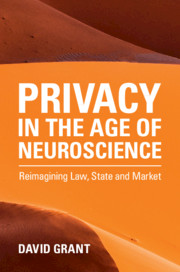Book contents
- Privacy in the Age of Neuroscience
- Privacy in the Age of Neuroscience
- Copyright page
- Contents
- Acknowledgements
- 1 Introduction
- Part I Privacy
- 2 Privacy, Neuroscience and Algorithms
- 3 The Frailty of Privacy Theory
- 4 Privacy as the History of Normalisation
- 5 Privacy, Its Values and Technology
- 6 A New Sense of Privacy
- Part II Regulation
- Bibliography
- Index
2 - Privacy, Neuroscience and Algorithms
from Part I - Privacy
Published online by Cambridge University Press: 09 April 2021
- Privacy in the Age of Neuroscience
- Privacy in the Age of Neuroscience
- Copyright page
- Contents
- Acknowledgements
- 1 Introduction
- Part I Privacy
- 2 Privacy, Neuroscience and Algorithms
- 3 The Frailty of Privacy Theory
- 4 Privacy as the History of Normalisation
- 5 Privacy, Its Values and Technology
- 6 A New Sense of Privacy
- Part II Regulation
- Bibliography
- Index
Summary
We need to understand neuroscience as an emanation of artificial intelligence. By that, a range of methods is being used to understand not only how the brain functions but also how it might be brought to function. Such neural change will increasingly come from connecting the brain to external sources of intelligence, both artificial and human. Yet the algorithms that are driving these developments are not neutral. As the world is itself increasingly being claimed to be algorithmic, we need to see not only that algorithms – and the data they interpret – are designed but that this design carries personal and cultural presumptions. We are re-creating the world through algorithms and that is both a form of idealism and one which is, because of that cultural frame, mythological in the sense of the dominant social dynamic. That is, because algorithmic designs are not determined by each individual, they are technologies of subjection, willing embraced or imposed. They are formative not only of the world but also of the individual self. This process is as evident in virtual and augmented realities as it is in clinical neuroscience.
Keywords
- Type
- Chapter
- Information
- Privacy in the Age of NeuroscienceReimagining Law, State and Market, pp. 25 - 70Publisher: Cambridge University PressPrint publication year: 2021

